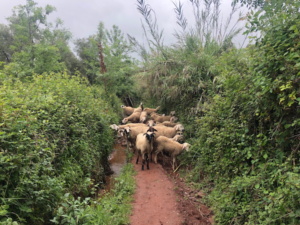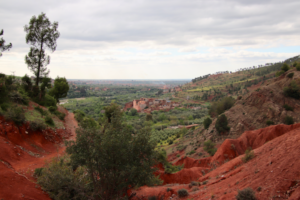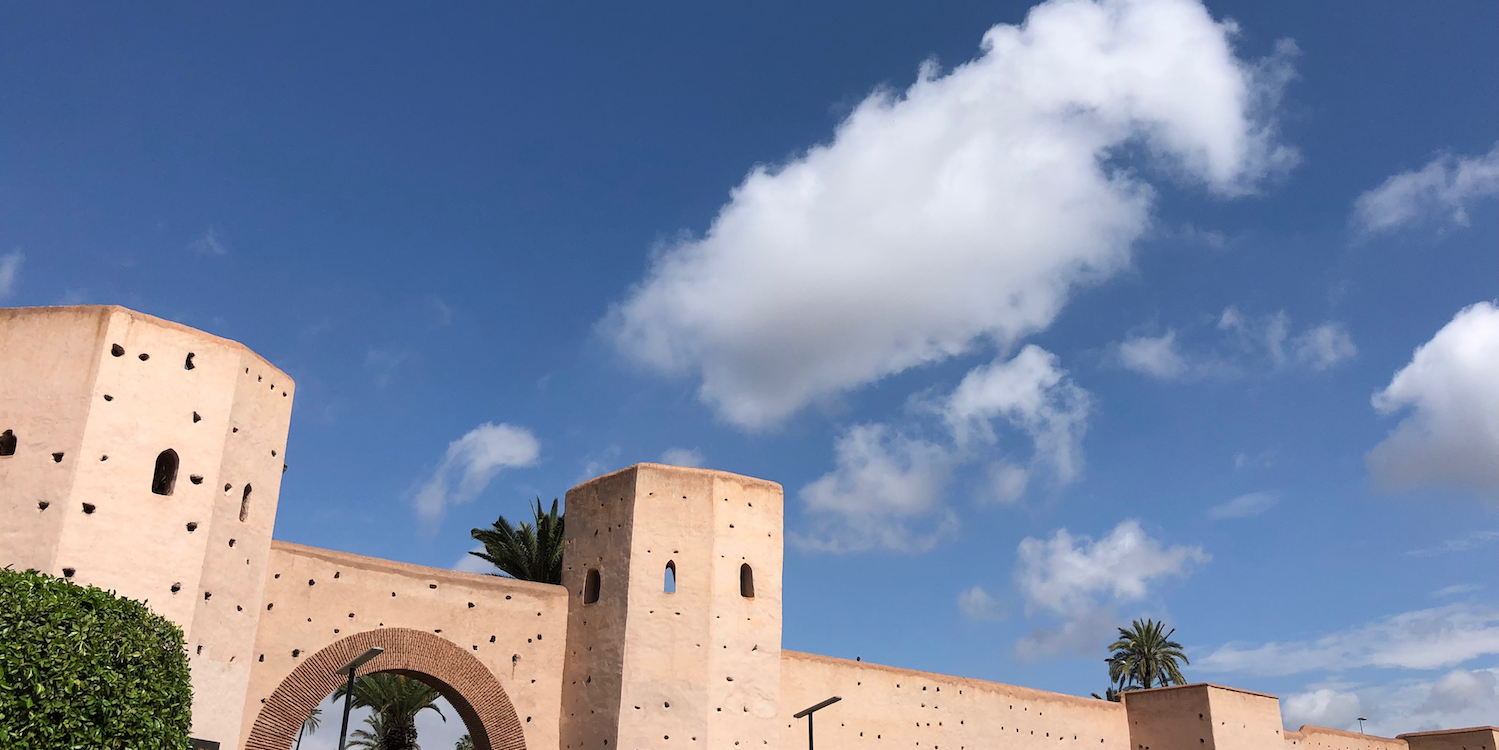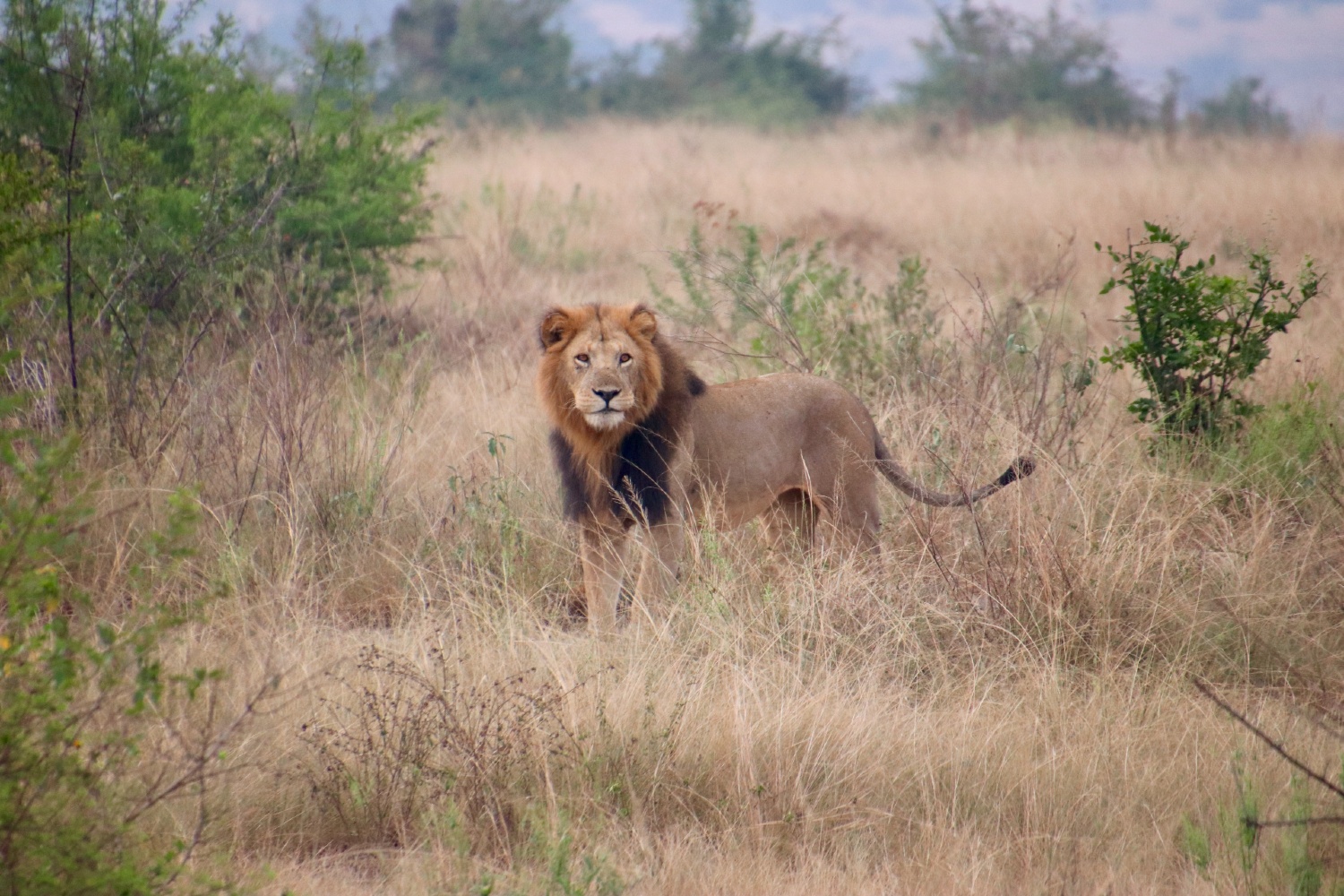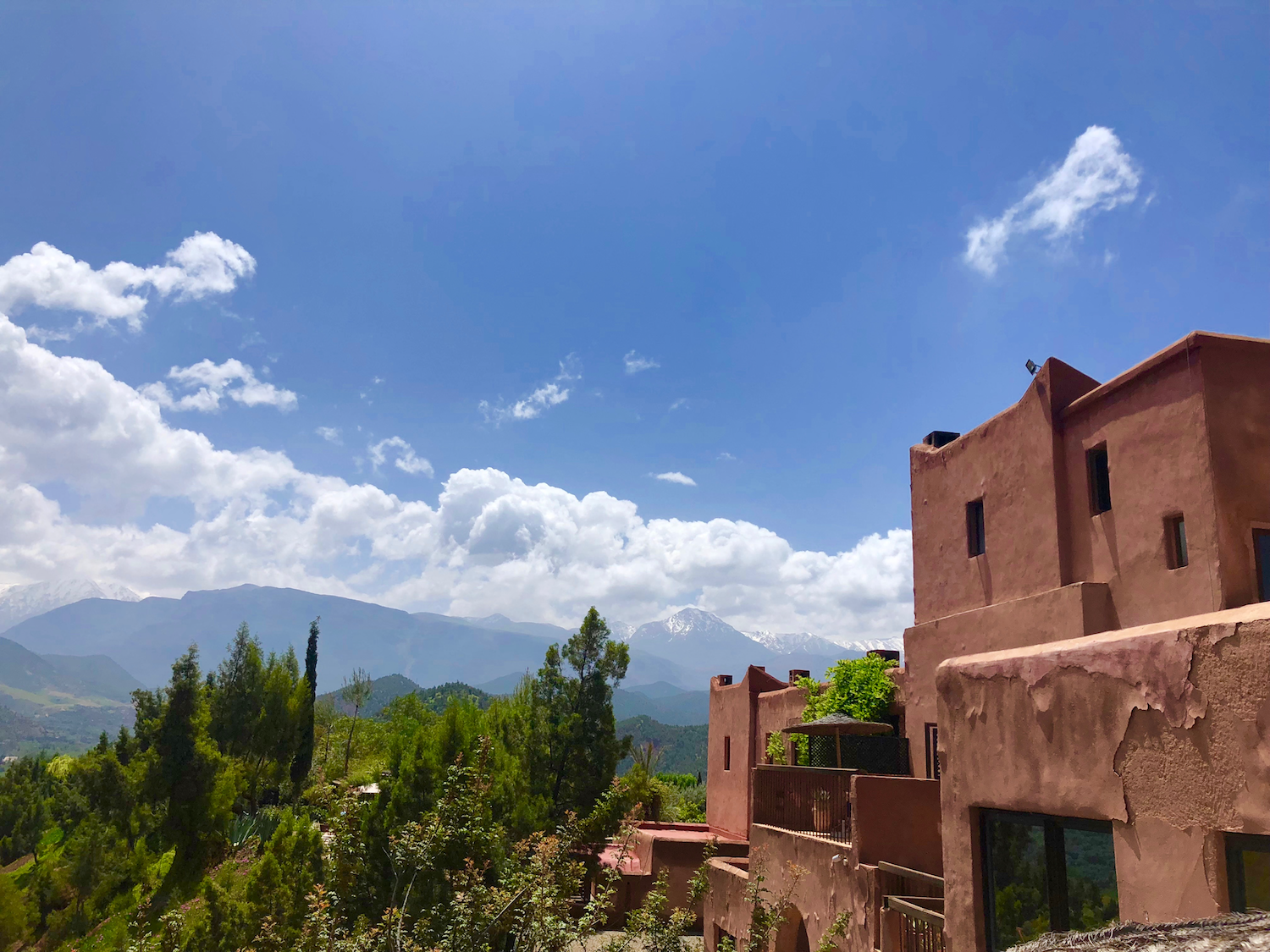
Travel research makes me happy, and I can spend hours finding ‘the best’ of anything. Sometimes though, my husband just nails it, and discovers the best places to stay, or eat. In the case of Morocco’s Atlas Mountains, he won, finding the hidden, beautiful gem, Kasbah bab Ourika, just outside of Marrakech.
Kasbah Bab Ourika, Atlas Mountains, Morocco /
Thirty minutes into the hour-long journey to Ourika from Marrakech, the road narrowed to a single lane, and became dark red packed earth. We slowed to about 5 mph and ambled past donkeys carrying bushels of barley, women with terra cotta tagines balanced gracefully on their heads, and the village elder, a 106 year-old man, staring absentmindedly into space. Welcome to village life around Ourika, nestled gently in the High Atlas Mountains.
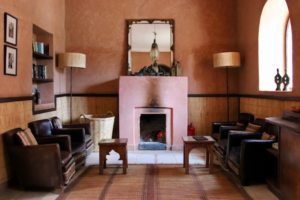
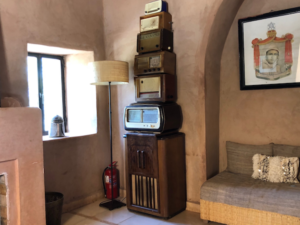
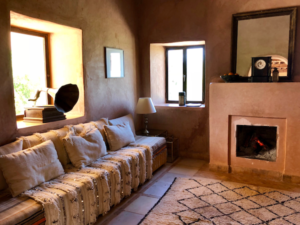
Kasbah Bab Ourika is a unique rustic oasis. The rooms are classic Berber, but with a twist. Wool rugs, and lovely woven tapestries as you’d expect, but then they add in a stack of vintage radios, black and white 12-inch TVs, a phonograph player, and the occasional antique steamer trunk. And yes, somehow this mismatched decor works together beautifully. Hidden alcoves for playing cards and board games, drinking the ever-present mint tea, or reading. Fireplaces in the common rooms add to the cozy and intimate ambience. Think Berber shabby chic.
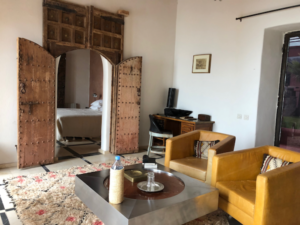
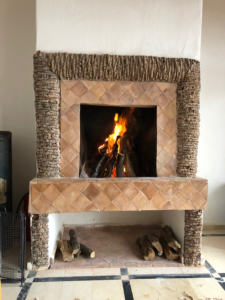
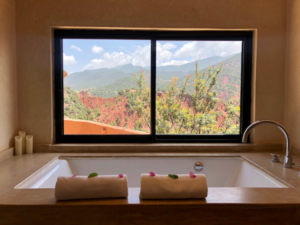
Rooms are minimal, yet thoughtfully-appointed, warm and sun-drenched. A daybed nook complete with novels and a reading lamp were especially inviting. We were welcomed to our room with rose petals flung all about, a deep sunken bathtub revealing a mountain panorama, and a garden roof top that boasted both sunrise and sunset views! At any moment, the attentive staff is happy to light the fire in your room, to warm up the cool nights.
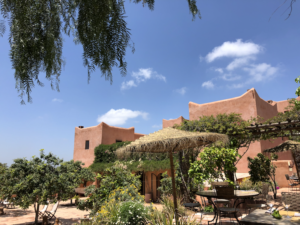
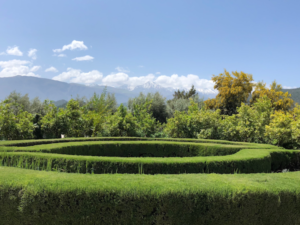
Sweeping views
But for all of the beauty that the kasbah has within it’s dusty orange earthen walls, it is equally, if not more about what is outside. The snow-capped mountain peaks, the flower gardens and olive groves, the mature fig trees that dot the property along with essence of lemon and orange trees. The quintessential reds and oranges of the kasbah juxtaposed beautifully against the cerulean blue sky. The air is crisp and clean, and you can hear the water flowing from the mountain into the gushing river nearby (which can oddly sound like traffic to those familiar with city life).
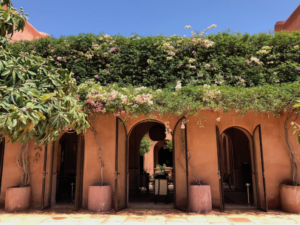
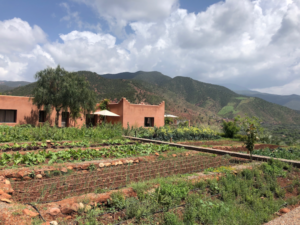
Clouds roll through, creating magical textured layers of blues and lavenders, while a sharp mountain silhouette completes the picture. Rosemary hedges surround the property and no matter where you are you can catch a telltale wisp of the herb. Desert cacti, evergreens and tropical palms somehow live in harmony here, naturally irrigated by the mountain run-off. Lush, rich, verdant and alive… the vegetable and herb gardens are the source of the decadent meals we came to love each day. Three course lunches and dinners, with just the perfect amount of variety, so much so, that we never tired of the Moroccan cuisine in our five night stay. Highlights, aside from the classic tagines, were lamb chops with roasted potatoes, slow-cooked chicken in herbs, homemade soups, and the many enticing salads that accompanied each meal. We drank Moroccan wine, which complimented the flavors of the tagines to perfection!
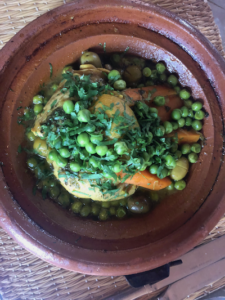
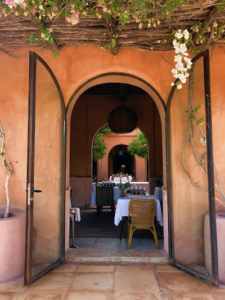
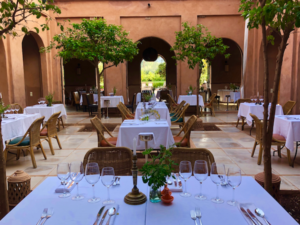
Dining took place in different areas around the property. Lunches under a bamboo-thatched rooftop on the patio facing the mountains and valleys, candlelit dinners in the inner courtyard, and places for cocktails in so many unique little spots that we often couldn’t choose. Kasbah Bab Ourika employs 60 villagers from the surrounding villages, which means 60 local families have steady income outside of farming. The staff is friendly and courteous, there to cater to your every need: mint tea in the library, a bottle of rosé on your terrace, or to light the fireplace in your room each night before you return from dinner. A prehistoric glow from the tiled fireplace casting an ethereal warmth on the earth-toned walls. Our hiking guides were also from the Berber villages, and were gentle and mindful, allowing us to get lost in our thoughts, and yet giving us enough local information as we wandered.
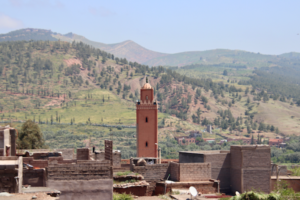
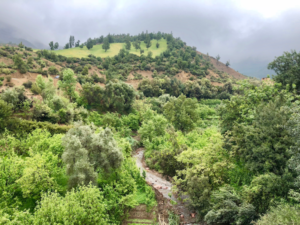
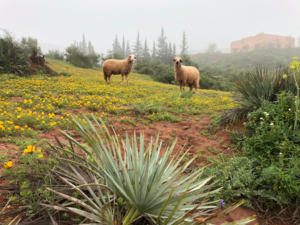
At one point we hiked through a steep mountain village, passing it’s ubiquitous tall, rectangular mosque, and came upon a dramatic vista. I saw five village elders in their dark woolen robes, cowls draped over their heads. They were ratcheted one by one up a gentle slope with their backs to me, admiring the sweeping mountain peaks in front of them. The unending layered hues of green and blues in all their majesty, a mystical cloud of fog hovering below the peaks, it was a photo worthy of National Geographic, I was convinced! But, as I was well aware, it is considered rude to take photos of the Berbers without permission, and so with a sigh of defeat slowly lowered my camera in respect, and took a mental photo instead.
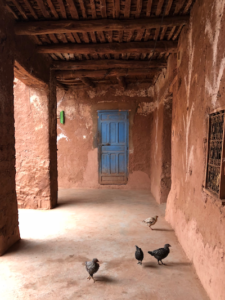
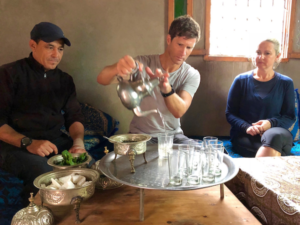
Hiking to a Berber Village
On one morning hike, we trekked two or three hours into the mountains, and were welcomed by a village family. No roads to be found, only donkey tracks and the occasional moped. They taught us the ceremonial process of making Berber mint tea, which you can find in every incarnation throughout the country. The technique involved pouring and re-pouring, first of green teas leaves to coat the tea pot, then hot water, then the mint leaves themselves, then the steeping, straining and adding of sugar. Lastly, was the theatrical way the tea is poured, which was from much higher above the glass cup then is necessary, but adds such drama! The result? Well suffice it to say, it put Tazo to shame.

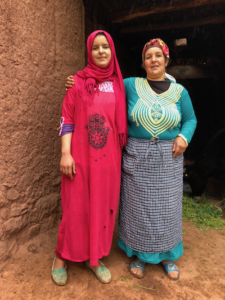
We were then served homemade breads along with freshly churned butter and pressed olive oil from the trees surrounding the village. The homes looked in a half-state of completion with up to six or more members of the family under the one roof, along with their livestock. It was a mystical experience, especially made so by the low-lying clouds that added to the striking backdrop. We felt like we were happily hidden away in the middle of nowhere.
We had unseasonably cool weather for April, which made the hiking easier, yet we were still able to spend a few days lazing by the pool in an intimate setting among the wildflowers, vivd red poppies and olive groves. Since the only place you could capture any wi-fi was a twenty square foot area in the kasbah courtyard, everywhere else you felt completely disconnected from the outside world, which was heavenly. The courtyard became a hive of social activity for the guests, all trying to get their internet fix, post a pic, or send a text.
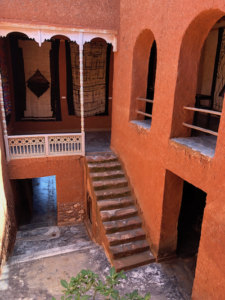
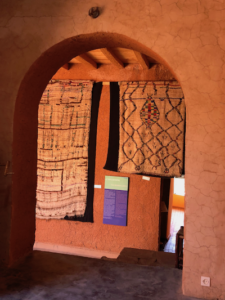
The Berber Museum
As difficult as it was to leave, we did manage a few other excursions from the kasbah grounds. While none of us had much of a desire to see the Berber Museum, it turned out to be a true highlight. Set in a small village, and having once been a traditional Berber home, our guide was charismatic and charming, and taught us much about Berber life in under an hour (which is my bandwidth for any museum). The stories of the tapestries being particularly fascinating, as the patterns woven determined if the rug was for a man, women, pregnant woman, or a even a wedding gift. The tapestries telling the stories of the villagers.
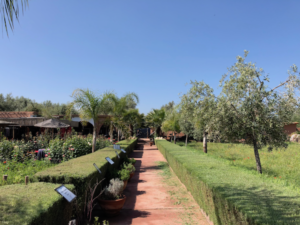
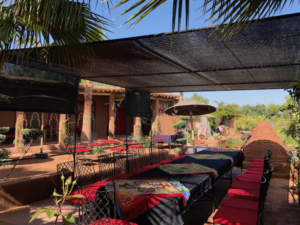
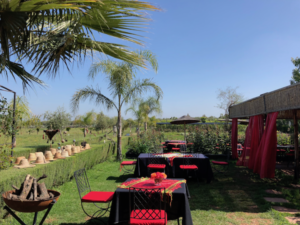
Paradis du safran, a hidden gem
We then went to Paradis du Safran, a hidden gem well off the main roads of Ourika, which was conceived and designed in 2012 by an entrepreneurial Swiss woman named Christine Ferrari. From nothing, she built the most awe-inspiring and verdant oasis. Paths of herbs, fruit trees, vivid gardens with flowers of every species, donkeys that look healthy (in contrast to nearly every other donkey we saw in Morocco), and even a resident peacock who kindly opened up it’s feathers to full plume as if on command. Ms. Ferrari served us rose petal water followed later by thyme tea as we sat and took in the expansive, colorful grounds.
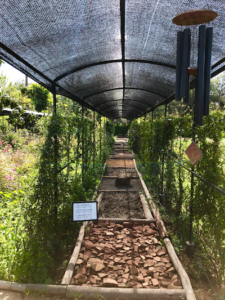
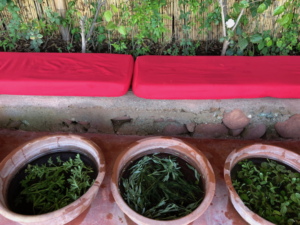
She has uniquely created a textural path, meant to be walked through barefoot. Stepping on pinecones, straw, ropes and twigs, among other things, was a sensory obstacle course for your feet. Afterwards, you can soak in a sequence of herbal foot baths that re-invigorates your senses, before dining at her al fresco restaurant or perusing her small yet well-curated boutique. It is a blissful, natural wonderland she has built, and while it seemed off the beaten path, she has a devoted following as we could see from the pinned map of the world she has at her entry. People have traveled from all ends of the earth to visit. And it is not surprising why, as it is just about as close to garden perfection as you can get, set magically against the snow-capped Atlas Mountains.

Cocktails and sunsets
The famous African sunsets did not let us down, and were an illustrious show to be seen nightly. We would spend an hour or so watching the sun make it’s fiery descent, each night more spectacular than the last. Each time saying that it couldn’t get any better and yet, somehow it did. And while the sun went down, watching how the mottled clay facets of the kasbah walls changed with each passing minute.
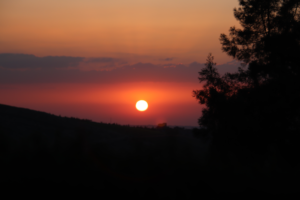
Some sunsets looked dusty rose, while the others took on a much darker hue depending on where the light was coming from. The packed earth on the mountains taking an almost merlot to deep purple palette, the cocoa colored latticework of the windows adding to the contrast. Then the icy blues and layers of the Atlas mountains…. it looked like my daughter’s latest eyeshadow palette, all the colors of the terra cotta mixing and blending together at once. On one particular sunset, a layer of clouds formed and we oooh-ed and ahhh-ed as we saw the sun disappear and then re-appear from below it, forming a magical golden lining.
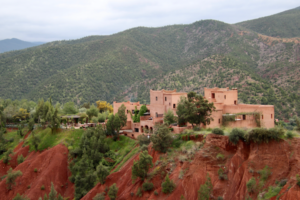

We woke before sunrise on our final morning to catch an early flight. Dark at first, the full moon still casting an ethereal glow. Then the sun edged out the moon, it’s rays gently hitting the tips of the snow caps in all shades of pink. We slowly tumbled down the mountain road, careful not to hit any farmers, their donkeys in tow, on their way to the morning market. Past the vegetable sellers opening their stalls, the women laying out their wares, and groups of men crouching at the pop-up roadside stalls having breakfast. As we drove, a final poetic slice of life in Morocco: a group of twenty or more brown woolen cloaked sheep herders, each with their prize sheep at their feet. A tornado of activity as the trading began to unfold, furious waving and posturing, sheep wrangling, baaa-ing, and milling about. Watching the scene grow distant as I looked out the rear window, I smiled. Over three thousand miles away from my home, and I was already trying to figure out a way to come back.
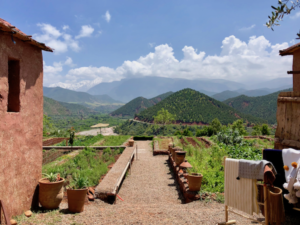
Five Reasons to get lost:
• Hiking to a remote Berber village and being welcomed like family.
• Meandering though the omnipresent arches of the kasbah, and finding a nook to enjoy nightly cocktails.
• Indulging in a glass of mint tea with the locals.
• Spontaneously coming upon a sheepherder and his flock in the mountains.
• Catching a glimpse of market life at 6am on Mondays.
Bonus:
Spend a few nights in colorful Marrakech. The Mandarin Oriental was the perfect distance from the hustle and bustle, a true oasis in the city.
